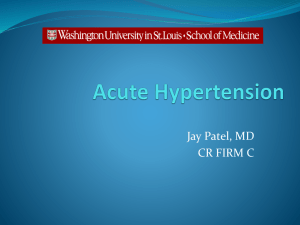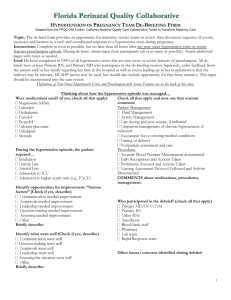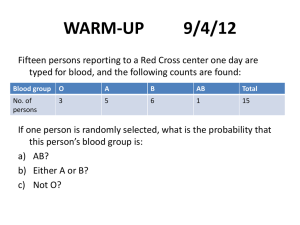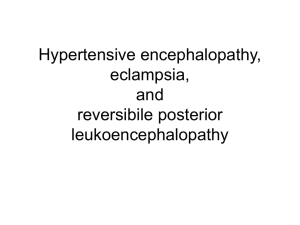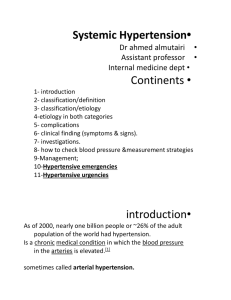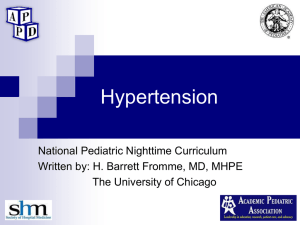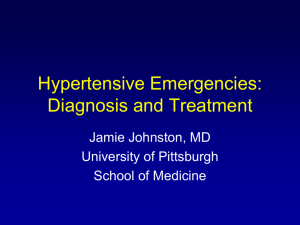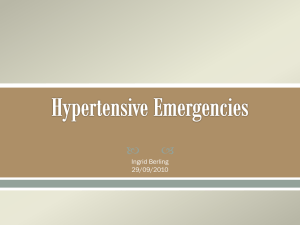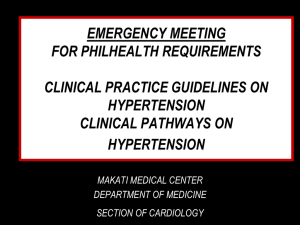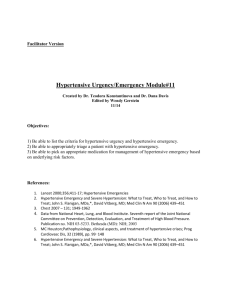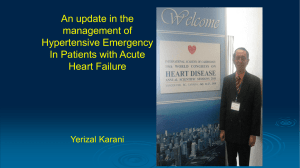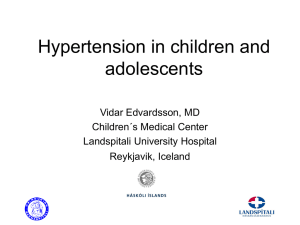Drugs for HTV emergencies A
advertisement
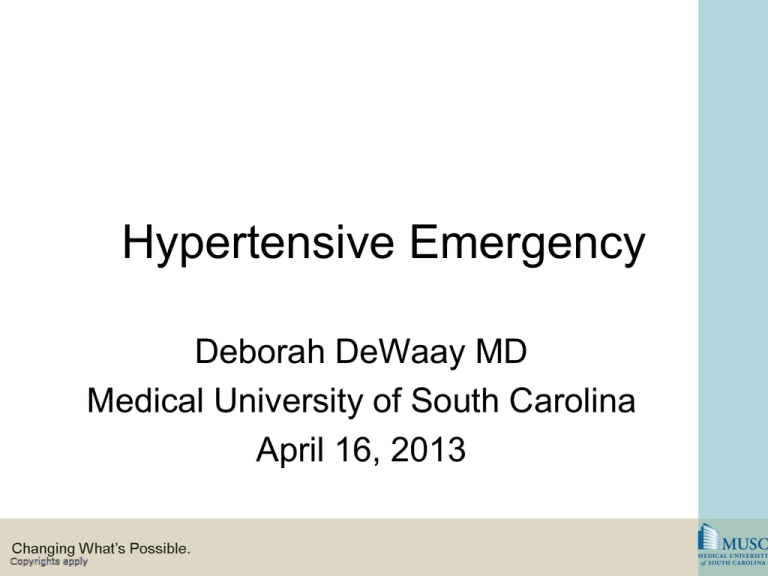
Hypertensive Emergency Deborah DeWaay MD Medical University of South Carolina April 16, 2013 Objectives Knowledge. Residents should be able to: • Define hypertensive emergency and describe the signs and symptoms of conditions associated with it • Describe the epidemiology of hypertensive emergency • Describe the prognosis of hypertensive emergency untreated and treated • Describe the uses of the drugs commonly used to treat hypertensive emergencies. Objectives • Skills – Understand which physical exam maneuvers and labs are important to diagnosing HTN emergency • Attitude – Residents should understand and appreciate that hypertensive emergency is a serious illness that carries a significant morbidity and mortality Key Messages • 1-2% of patients with systemic hypertension will develop hypertensive emergency • HTN emergency needs to be treated with IV drips, not IV push • HTN emergency should be treated in the ICU The Old • Malignant hypertension is not a term that is used any more • It was used to mean elevated BP + encephalopathy or AKI Hypertensive Emergency • Elevated blood pressure with symptoms – – – – – – Shortness of breath (29%) Chest pain (26%) Headache (23%) Altered mental status (20%) Focal neurologic deficit (11%) Microangiopathic hemolysis (27%) • There is no absolute BP cut off • The rate of increase is as important as the absolute BP Hypertensive Urgency • Elevated blood pressure without symptoms • JNC 7 does not specifically define a BP number for HTN urgency – Stage 2 hypertension is SBP≥160 mmHg, DBP≥100 mmHg – Hypertensive crisis is SBP≥179 mmHg, DBP≥109 mmHg Epidemiology • Systemic hypertension affections 1 billion people world wide and 65 million Americans • 1-2% of patients with systemic hypertension will develop hypertensive emergency • Men are affected 2x more than women • More common in the elderly and AfricanAmericans • Essential HTN accounts for 20-30% of HTN emergency in whites, but over 80% in AfricanAmericans Prognosis • Per one study in 1939, untreated malignant hypertension has a 79% 1 year mortality with a median survival of 10.5 months • Mortality has decreased in recent years – One study showed that the 5 year survival was 32% prior to 1977, but between 1977 – 2006 it increased to 91% • Per Studying the Treatment of Acute Hypertension (STAT) registry: in hospital mortality for HTN emergency was 6.7%, 90 day mortality of 11% History • Medication history – Anti- HTN meds – OTC meds – Illegal drugs: especially cocaine, amphetamines, phencyclidine • HTN? – History of control – Compliance Physical Exam • Blood pressures in both arms and orthostatics • Pt should be seated with the back supported and legs uncrossed • If the cuff is too small, the BP will be falsely elevated • Per American Heart Association – – – – Arm circumference 22 - 26 cm, small adult cuff, 12x22 cm Arm circumference 27 - 34 cm, adult cuff, 16x30 cm Arm circumference 35 - 44 cm, large adult cuff, 16x36 cm Arm circumference 45 - 52 cm, adult thigh cuff, 16x42 cm Physical Exam • • • • • • Neuro exam Cardiac exam Pulmonary exam Ocular exam: only happens in 13% of pts Extremity exam [they are critically ill so need a full exam] Labs to consider • • • • • • • BMP CBC with peripheral smear, LDH UA EKG CXR CT head Echocardiogram Pathophysiology • The DD genotype of the angiotensinconverting enzyme (ACE) gene has been found to be associated with increased risk of HTN emergency • Overall cause is poorly understood • One theory is that there is a triggering factor that causes the release of humoral vasoconstrictors leading to an increased in systemic vascular resistance (SVR) Pathophysiology ↓organs ability to autoregulate SVR eventually blood flow mechanical wall stress & endothelial injury Pressure naturesis RAS Vasoconstriction Ischemia triggers coagulation cascade fibrin disposition fibrinoid necrosis of arterioles • Brain: The Effects – CVA: ischemic, hemorrhagic – Hypertensive Encephalopathy • Heart: – Myocardial infarction – Heart failure: systolic, diastolic • Aorta: – Aortic dissection • Kidney: – Acute kidney injury • Blood vessels – Microangiopathic hemolytic anemia – Retinal hemorrhages, exudates and papilledema Pathophysiology http://www.cardeneiv.com/a3_cardeneiv_ah_py.shtml Hypertensive Encephalopathy • Clinical presentation: acute or subacute lethargy, confusion, headache, visual disturbance or seizures • More common in patients with SLE, HUS, cryoglobulinemia, on cyclosporin or cisplatin – Diseases with underlying vascular disturbances Hypertensive Encephalopathy PRES: Posterior reversible encephalopathy syndrome Typically symmetrical white matter edema in the posterior cerebral hemispheres www.wikipedia.org • Normally CBF is unchanged between a MAP of 60-120 • As MAP increases autoregulation stops cerebral vasodilation edema • As endothelial damage occurs capillary leakage breakdown of blood brain barrier edema http://jap.physiology.org/content/91/5/1986/F1.large.jpg • Chronically hypertensive patients lose normal autoregulation in their brain. They require a higher BP to maintain CBF • Therefore the BP HTN emergency happens at is dependent on the patients baseline BP Goals of Tx: Hypertensive Urgency – Use oral medications – BP should be lowered gradually over 1-2 days – Rapid correction below autoregulatory range hypoperfusion ischemia and infarction Goals of Tx: Hypertensive Emergency • • • • Altered auto-regulation is present End-organ damage is already present Excessive correction can worsen damage Use IV infusion of a short acting, titratable medication • Use intra-arterial BP monitoring if severe clinical manifestations or labile BP • Goal: ↓DBP 15-20% or to about 110mmHg over 1-2hr – If dissection: this should be done in 5-10 minutes Other Important Points • ***Admit to ICU*** – Per STAT registry: only 15% of pts were admitted 1st line • Once BP is stable, PO should be started as gtt is titrated off • Do not use sublingual nifedipine or IV hydralazine because they lower BP too quickly Other Important Points • Don’t use nitroprusside (except with aortic dissection) because is will decrease BP to quickly, causes a decrease in cerebral blood flow and increases intracranial pressure • Many patients are volume depleted from pressure naturesis so use caution with diuretics BP will drop too quickly The Drugs • Nicardipine: – – – – 2nd generation dihydropyridine Ca ++ channel blocker Selective for the peripheral vasculature Cerebral vasodilatation Coronary vasodilatation • Clevidipine – 3rd generation dihydropyridine Ca++ channel blocker – Decreases SVR via relaxing smooth muscles of small arteries, increases CO and SV – Metabolized by plasma esterases so independent of liver and kidney function The Drugs • Labetalol: – Alpha 1 and non-selective Beta blocker (1:7 ratio) – Metabolized by liver – Maintains cardiac output, decreases SVR maintains peripheral blood flow • Esmolol – Ultra-short acting cardioselective beta blocker – Metabolized by RBC esterases, independent of liver and kidney function PE ACS New S4 Lab Drug EKG, Troponins CXR, EKG, BNP labetalol or esmolol + nitroglycerin nicardipine or clevidipine + nitro + loop diuretic Dia CHF + Crackles, Pulmonary JVD, LE Edema edema CXR, EKG, BNP Aortic Unequal Dissection pulses & BP Wide mediastinum on CXR; CT chest with contrast esmolol or labetalol or metoprolol or verapamil + nitro + loop diuretic labetalol or nicardipine + esmolol or nitroprusside + esmolol Sys CHF + Crackles, Pulmonary JVD, LE Edema edema PE Acute Kidney Injury Edema, ocular exam – retinopathy HTN Altered level of Encephalopathy consciousness CVA Hemolytic anemia Focal neurologic deficits CBC, haptoglobin, LDH, smear, LFTs Lab Drug elevated Cr, nicardipine, hematuria on clevidipine, UA fenoldopam CT head; MRI nicardipine, clevidipine, labetalol CT head with Same as angiography encephalop athy Anemia, nicardipine, schistocytes, clevidipine, low plts fenoldopam Pregnancy related end organ damage: pre-eclampsia, eclampsia, HELLP syndrome will not be addressed in this lecture. References 1. Marik P, Rivera R. Hypertensive emergencies: an update. Current Opinion in Critical Care 2011; 17:569-580 2. Deshmukh A, Kumar G, Kumar N, Nanchal R, Gobal F, Sakhuja A, Mehta J. Effect of Joint National Committee VII report on hospitalization for hypertensive emergencies in the United States. American Journal of Cardiology 2011; 108:1277-1282 3. Franklin S, Neutel J. Initial combination therapy for rapid and effective control of moderate and severe hypertension. Journal of Human Hypertension 2009; 23: 4-11 4. Aronson S, Dyke C, Stierer K, Levy J, Cheung A, Lumb P, Kereiakes D, Newman M. The ECLIPSE Trials: comparative studies of Clevidipine to Nitroglycerin, Sodium Nitroprusside, and Nicardipine for acute hypertension treatment in cardiac surgery patients. Anesth Analg 2008; 107:1110-21 5. Varon J. Treatment of Acute Severe Hypertension. Drugs 2008; 68(3): 283297 6. Vaughan C, Norman D. Hypertensive Emergencies. Lancet 2000; 356: 41117
